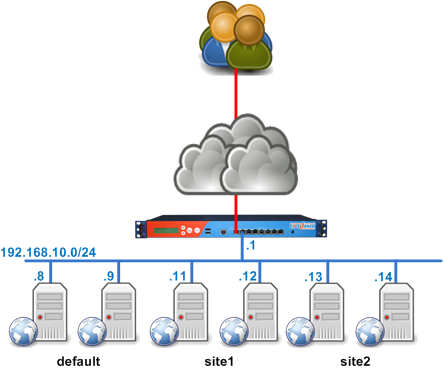To ensure high availability and performance of web applications, it is common to use a load balancer.
While some people use layer 4 load-balancers, it can be sometimes recommended to use layer 7 load balancers to be more efficient with HTTP protocol.
Learn more by registering for our webinar: “Introduction to HAProxy Stick Tables“
A Load Balancer in an Infrastructure
The picture below shows how we usually install a load balancer in an infrastructure: This is a logical diagram. When working at layer 7 (aka Application layer), the load balancer acts as a reverse proxy.
This is a logical diagram. When working at layer 7 (aka Application layer), the load balancer acts as a reverse proxy.
So, from a physical point of view, it can be plugged anywhere in the architecture:
in a DMZ
in the server LAN
in front of the servers, acting as the default gateway
far away in a separated data center
The Challenges of Load Balancing Web Applications
Well, HTTP is not a connected protocol: it means that the session is totally independent from the TCP connections. Even worse, an HTTP session can be spread over a few TCP connections…
When there is no load balancer involved, there won’t be any issues at all, since the single application server will be aware the session information of all users, and whatever the number of client connections, they are all redirected to the unique server.
When using several application servers, then the problem occurs: what happens when a user is sending requests to a server which is not aware of its session? The user will get back to the login page since the application server can’t access his session: he is considered as a new user.
To avoid this kind of problem, there are several ways:
Use a clustered web application server where the session are available for all the servers
Sharing user’s session information in a database or a file system on application servers
Use IP level information to maintain affinity between a user and a server
Use application layer information to maintain persistence between a user and a server
Building a web application cluster
Only a few products on the market allow administrators to create a cluster (like Weblogic, tomcat, jboss, etc…).
I’ve never configured any of them, but from Administrators I talk too, it does not seem to be an easy task.
By the way, for Web applications, clustering does not mean scaling. Later, I’ll write an article explaining while even if you’re clustering, you still may need a load balancer in front of your cluster to build a robust and scalable application.
Sharing user’s session in a database or a file system
This Technic applies to application servers which has no clustering features, or if you don’t want to enable cluster feature from. It is pretty simple, you choose a way to share your session, usually a file system like NFS or CIFS, or a Database like MySql or SQLServer or a memcached then you configure each application server with proper parameters to share the sessions and to access them if required.
I’m not going to give any details on how to do it here, just google with proper keywords and you’ll get answers very quickly.
IP source affinity to server
An easy way to maintain affinity between a user and a server is to use user’s IP address: this is called Source IP affinity. There are a lot of issues doing that and I’m not going to detail them right now.
The only thing you have to know is that source IP affinity is the latest method to use when you want to “stick” a user to a server.
Well, it’s true that it will solve our issue as long as the user use a single IP address or he never change his IP address during the session.
Application layer persistence
Since a web application server has to identify each users individually, to avoid serving content from a user to an other one, we may use this information, or at least try to reproduce the same behavior in the load balancer to maintain persistence between a user and a server.
The information we’ll use is the Session Cookie, either set by the load balancer itself or using one set up by the application server.
The Difference Between Persistence and Affinity
Affinity: this is when we use information from a layer below the application layer to maintain a client request to a single server
Persistence: this is when we use Application layer information to stick a client to a single server
sticky session: a sticky session is a session maintained by persistence
The main advantage of the persistence over affinity is that it’s much more accurate, but sometimes, Persistence is not doable, so we must rely on affinity.
Using persistence, we mean that we’re 100% sure that a user will get redirected to a single server.
Using affinity, we mean that the user may be redirected to the same server…
The Interaction With Load Balancing
In load balancer you can choose between several algorithms to pick up a server from a web farm to forward your client requests to.
Some algorithm are deterministic, which means they can use a client side information to choose the server and always send the owner of this information to the same server. This is where you usually do Affinity 😉 IE: “balance source”
Some algorithm are not deterministic, which means they choose the server based on internal information, whatever the client sent. This is where you don’t do any affinity nor persistence 🙂 IE: “balance roundrobin” or “balance leastconn”
I don’t want to go too deep in details here, this can be the purpose of a new article about load-balancing algorithms…
You may be wondering: “we have not yet speak about persistence in this chapter”. That’s right, let’s do it.
As we saw previously, persistence means that the server can be chosen based on application layer information.
This means that persistence is an other way to choose a server from a farm, as load-balancing algorithm does.
Actually, session persistence has precedence over load-balancing algorithm.
Let’s show this on a diagram:
client request
|
V
HAProxy Frontend
|
V
backend choice
|
V
HAProxy Backend
|
V
Does the request contain
persistence information ---------
| |
| NO |
V |
Server choice by | YES
load-balancing algorithm |
| |
V |
Forwarding request <----------
to the server
Which means that when doing session persistence in a load balancer, the following happens:
the first user’s request comes in without session persistence information
the request bypass the session persistence server choice since it has no session persistence information
the request pass through the load-balancing algorithm, where a server is chosen and affected to the client
the server answers back, setting its own session information
depending on its configuration, the load balancer can either use this session information or setup its own before sending the response back to the client
the client sends a second request, now with session information he learnt during the first request
the load balancer choose the server based on the client side information
the request DOES NOT PASS THROUGH the load-balancing algorithm
the server answers the request
and so on…
At HAProxy Technologies we say that “Persistence is a exception to load-balancing“.
And the demonstration is just above.
Affinity Configuration in HAProxy / HAProxy ALOHA load balancer
The configuration below shows how to do affinity within HAProxy, based on client IP information:
frontend ft_web
bind 0.0.0.0:80
default_backend bk_web
backend bk_web
balance source
hash-type consistent # optional
server s1 192.168.10.11:80 check
server s2 192.168.10.21:80 checkWeb Application Persistence
In order to provide persistence at application layer, we usually use Cookies.
As explained previously, there are two ways to provide persistence using cookies:
Let the load balancer set up a cookie for the session.
Using application cookies, such as ASP.NET_SessionId, JSESSIONID, PHPSESSIONID, or any other chosen name
Session cookie setup by the Load-Balancer
The configuration below shows how to configure HAProxy / HAProxy ALOHA load balancer to inject a cookie in the client browser:
frontend ft_web
bind 0.0.0.0:80
default_backend bk_web
backend bk_web
balance roundrobin
cookie SERVERID insert indirect nocache
server s1 192.168.10.11:80 check cookie s1
server s2 192.168.10.21:80 check cookie s2Two things to notice:
The line “cookie SERVERID insert indirect nocache”:
This line tells HAProxy to setup a cookie called SERVERID only if the user did not come with such cookie. It is going to append a “Cache-Control: nocache” as well since this type of traffic is supposed to be personal and we don’t want any shared cache on the internet to cache it.The statement “cookie XXX” on the server line definition:
It provides the value of the cookie inserted by HAProxy. When the client comes back, then HAProxy knows directly which server to choose for this client.
So what happens?
At the first response, HAProxy will send the client the following header, if the server chosen by the load-balancing algorithm is s1:
Set-Cookie: SERVERID=s1For the second request, the client will send a request containing the header below:
Cookie: SERVERID=s1Basically, this kind of configuration is compatible with active/active HAProxy ALOHA load balancer cluster configuration.
Using application session cookie for persistence
The configuration below shows how to configure HAProxy / HAProxy ALOHA to use the cookie setup by the application server to maintain affinity between a server and a client:
frontend ft_web
bind 0.0.0.0:80
default_backend bk_web
backend bk_web
balance roundrobin
cookie JSESSIONID prefix nocache
server s1 192.168.10.11:80 check cookie s1
server s2 192.168.10.21:80 check cookie s2Just replace JSESSIONID with your application cookie. It can be anything, like the default ones from PHP and IIS: PHPSESSID and ASP.NET_SessionId.
So what happens?
At the first response, the server will send the client the following header
[sourcecode language=”text”]Set-Cookie: JSESSIONID=i12KJF23JKJ1EKJ21213KJ[/sourcecode]when passing through HAProxy, the cookie is modified like this:
Set-Cookie: JSESSIONID=s1~i12KJF23JKJ1EKJ21213KJNote that the Set-Cookie header has been prefixed by the server cookie value (“s1” in this case) and a “~” is used as a separator between this information and the cookie value.
For the second request, the client will send a request containing the header below:
Cookie: JSESSIONID=s1~i12KJF23JKJ1EKJ21213KJHAProxy will clean it up on the fly to set it up back like the origin:
Cookie: JSESSIONID=i12KJF23JKJ1EKJ21213KJBasically, this kind of configuration is compatible with active/active HAProxy ALOHA load balancer cluster configuration.
What happens when a server goes down
When doing persistence, if a server goes down, then HAProxy will redispatch the user to an other server.
Since the user will get connected on a new server, then this one may not be aware of the session, so be redirected to the login page.
But this is not a load balancer problem, this is related to the application server farm.
Conclusion
In this blog post, you learned why and how to use a load balancer and how it fits into a common infrastructure. You also learned what Affinity, Persistence and Sticky Sessions are, as well as the differences between them.
HAProxy Enterprise combines HAProxy Community, the world’s fastest and most widely used, open-source load balancer and application delivery controller, with enterprise-class features, services and premium support. It is a powerful product tailored to the goals, requirements and infrastructure of modern IT. HAProxy ALOHA is a plug-and-play hardware or virtual load balancer based on HAProxy Enterprise that supports proxying at Layer 4 and Layer 7.
Contact us to learn more and sign up for a free trial of HAProxy Enterprise or HAProxy ALOHA Virtual. If you enjoyed this post and want to see more like it, subscribe to our blog! You can also follow us on Twitter and join the conversation on Slack.
Subscribe to our blog. Get the latest release updates, tutorials, and deep-dives from HAProxy experts.



